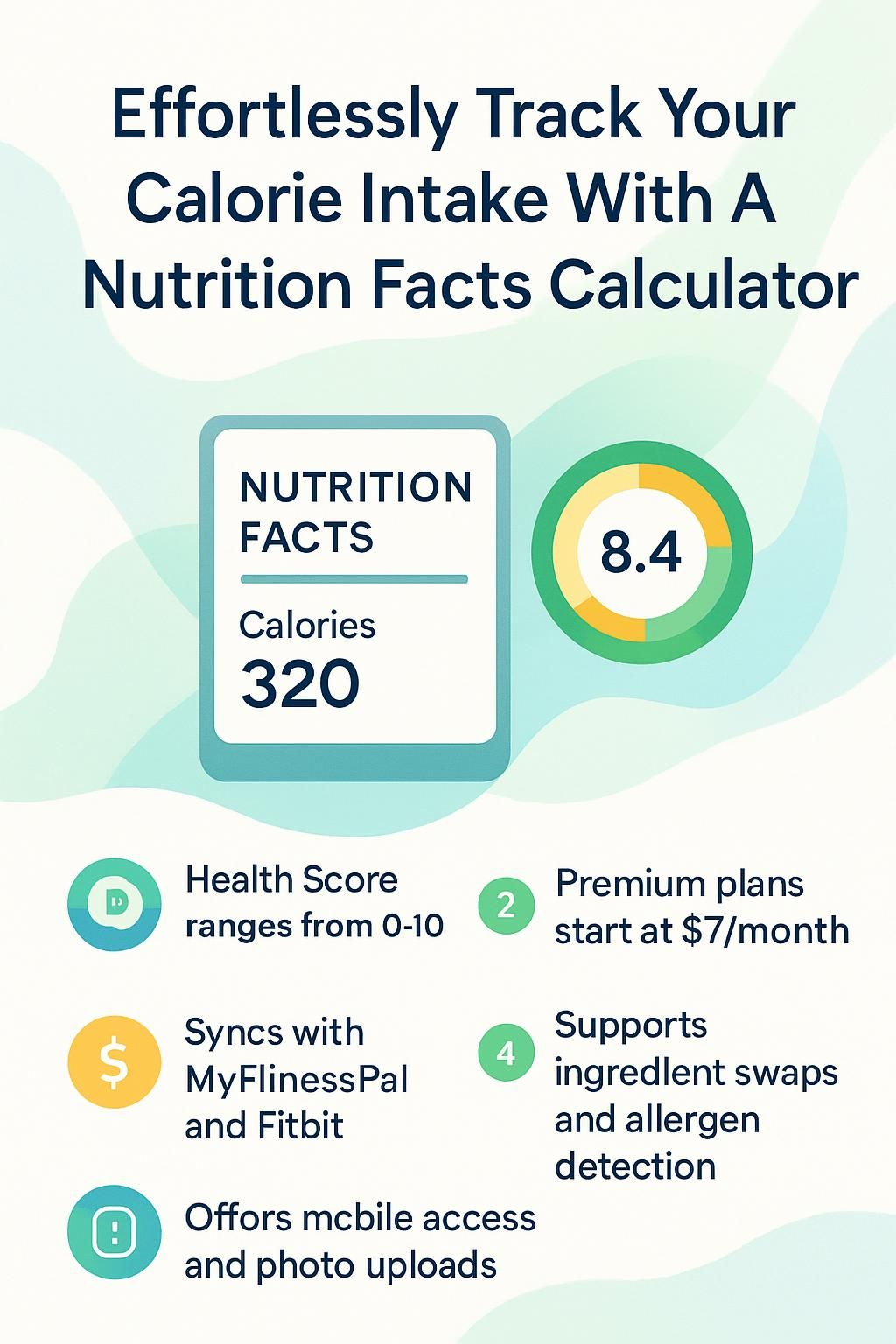Effortlessly Track Your Calorie Intake With A Nutrition Facts Calculator
Our Nutrition Assistant AI Suite will transform your body. You will lose fat, get toned, and build muscle. Gain confidence and optimal health.
Tracking calories can feel confusing, especially with homemade meals. A Nutrition Facts Calculator gives clear nutrition information for every ingredient and serving, right on your phone or computer.
In a few steps, you see fat, protein, carbs, fiber, and key vitamins for any recipe. A recipe nutrition calculator also suggests serving sizes and helps you plan smarter meals with less guesswork.
Read on to learn simple, proven ways to manage daily intake with tools that fit your routine.
Key Takeaways
- Nutrition calculators use trusted databases, such as USDA FoodData Central and ESHA, to estimate calories and nutrients, plus quality scores like Health Score (0–10) and Nutrition Balance Score (up to 110).
- Paid plans, starting at $7 per month for 50 analyses and $19 for unlimited, generate FDA-style nutrition labels for professional packaging or business needs.
- Many tools sync with fitness apps like MyFitnessPal and Fitbit, combining food data with activity for real-time calorie tracking.
- Quick ingredient swaps, custom portions, and allergen flags support meal planning for specific diets and sensitivities.
- Frequent database updates, mobile access, photo uploads, and auto-analysis features improve accuracy and speed as of 2024.

What Is a Nutrition Facts Calculator?

A Nutrition Facts Calculator analyzes the nutritional value of foods and recipes. You enter ingredients and serving sizes, then it calculates calorie content and a complete nutrition facts label for your menu.
What does a Nutrition Facts Calculator do?
The calculator builds nutrition facts labels for any dish. After you add ingredients and portion sizes, it shows calories, macronutrients like protein, carbohydrates, and fat, plus vitamins and minerals that matter to health.
You can track calories per serving or for the whole recipe. Many tools let you compare versions, adjust values, and see how small changes shift the final totals.
Quality metrics add context. You may see a Health Score on a 0–10 scale and a Nutrition Balance Score up to 110, along with allergen flags based on your inputs. Last week, I used a recipe analyzer for a bean and milk dish, and it matched my Reference Daily Intake targets without manual math.
Using a nutrition facts calculator made meal prep easier since I no longer had to calculate nutrient content by hand.
How does a Nutrition Facts Calculator work?
Start by entering your recipe in a clean form. List each ingredient on its own line with exact amounts and units. Many tools support search by recipe name or photo uploads, using AI to recognize common ingredients.
Edit items with a pencil icon, add new ones with +Add Ingredient, or tap Start Over to reset. The calculator analyzes each entry and displays calories by ingredient and totals for the full recipe.
Results show macronutrients and micronutrients per serving, which supports personal plans on websites or within healthcare portals. AI can also adjust custom portion sizes so your numbers reflect activity goals or body mass index targets. During spring meal prep, these features helped me track health details without confusion.
Key Features of a Nutrition Facts Calculator
A Nutrition Facts Calculator gives a clear view of calories and nutrients for every recipe. It also helps you compare ingredients so you can make better choices.
How does it break down calories by ingredient?
Each ingredient displays its exact calorie share as you type. For example, adding 100 grams of chicken and 1 cup of cooked rice shows separate calorie counts for each item.
A simple table lists items, weights, and calories. Swap whole milk with low fat milk and watch the totals change instantly. Edit a quantity or remove an item, and the recipe calories update right away.
This approach shows where extra calories come from, which makes trimming them easier. I used it during batch cooking, and switching to lighter oils cut calories without hurting flavor.
Seeing each item’s impact on my daily intake made choosing healthier swaps much easier.
What is macronutrient analysis (carbs, protein, fats)?
Macronutrient analysis breaks down carbohydrates, protein, and fat per serving. The label shows grams and percent Daily Value based on a 2,000 calorie diet.
For carbs, you see total carbs, fiber, sugars, and added sugars. For fats, you can view total fat with saturated and trans fats. These details reveal where your energy comes from and how it supports your goals.
When I planned work lunches last year, this view helped me find dishes that were too high in fat and too low in fiber. Adjusting recipes before cooking saved time and improved balance.
How does it track vitamins and minerals?
The calculator reports vitamins such as A, C, D, E, K, and the B vitamins, including folate. Values appear in milligrams or micrograms and as a percent of Daily Value, which follows FDA guidance.
It also lists minerals like calcium, iron, magnesium, potassium, and zinc. For nutrients with suggested limits, such as sodium and cholesterol, you see totals next to recommended caps. This helps you judge a recipe at a glance.
Can serving sizes be customized?
Serving sizes are fully customizable. Select the number of servings, enter a custom portion, or choose total weight per serving to match how you plate food.
As you change portions, the AI recalculates the label instantly. This makes meal prep and recipe tweaks more accurate in daily life.
Benefits of Using a Nutrition Facts Calculator
A Nutrition Facts Calculator supports clear goals and daily consistency. These benefits help you improve habits with less stress.
How does it help track calorie intake accurately?
Accurate calorie tracking starts with strong data. Many calculators use the ESHA database, known for precise food values, and adjust totals based on your serving sizes.
You can add foods to Daily Totals to see your day in one place. Usage stats over days or months reveal patterns and help you notice trends early. After entering a homemade pasta recipe, I saw exact calories per serving, which kept portions in check.
How can it improve dietary planning?
Once your calorie tracking is set, planning improves too. Filters for cost, prep time, cuisine, and dietary preference guide you to meals that fit both goals and schedule.
Ingredient comparisons highlight better choices. If a dish runs high in calories or low in fiber, swap items to improve it. Replacing sour cream with Greek yogurt often trims calories and boosts protein.
Saving recipes by category and portion size speeds up weekly prep. Reliable data from USDA FoodData Central supports smart planning with up-to-date nutrition values.
Can it support weight management goals?
The calculator reports calories and macronutrients for every recipe, plus quality markers like Health Score and Nutrition Balance Score. These show balance at a glance.
You can set targets for protein, carbs, and fats, then track progress each day. If you need fewer calories or more protein, adjust ingredients and see the changes live. Many people pair these tools with meal plans to support weight loss or strength goals.
How does it help understand nutrient content better?
Calories tell only part of the story. The label also shows fiber, vitamins, minerals, and nutrients that may need limits, such as added sugar or saturated fat.
The calculator compares your recipe to common targets. It flags nutrients that are too high or too low so you can adjust sooner. These insights replace guesswork with numbers you can use.
How to Use a Nutrition Facts Calculator Effectively
Good inputs lead to good results. Accurate amounts and clear serving sizes deliver reliable labels in seconds.
How do you input ingredients and serving sizes?
Enter one ingredient per line with exact amounts and units. For instance, type “2 cups spinach” or “100 grams chicken breast.” Most tools include a search bar to find items in their database quickly.
Some calculators let you upload a photo, then use AI to suggest ingredients. Set the number of servings your recipe makes so the tool can calculate nutrients per portion.
I follow this process each weekend when planning family meals. Searching, confirming amounts, and saving recipes keeps my plan fast and consistent.
How to adjust for recipe variations?
Recipes change. Use the pencil icon to edit or remove an item, or press +Add Ingredient for a new one. For example, replace whole milk with low fat milk to compare results right away.
During prep last week, I swapped butter for olive oil in the calculator. Calories dropped from 250 to 210 per serving with one quick edit. If you change many items at once, reset the analysis to keep data clean.
How should you interpret the results?
Start with calories, macronutrients, and the % Daily Value for each nutrient. Focus on limits, such as saturated fat, sodium, and added sugar, to protect your targets.
Use Health Score and Nutrition Balance Score as quick quality checks. If a score is low or limits are high, adjust ingredients or the portion size. Small changes can make a large difference over a week.
Advanced Features of Modern Nutrition Calculators
Modern tools do more than add numbers. They connect your food data with your daily routine.
How do they integrate with fitness apps?
You can export your data to apps like MyFitnessPal or Fitbit. Many calculators include Daily Totals that sync with your trackers for smooth updates.
Food entries from your phone can combine with workout data from your watch. When I trained for a 5K, syncing meals with my running app showed if my energy matched my training.
Integration saves time, prevents typing errors, and keeps your progress in one place.
What are smart serving size recommendations?
Smart serving tools use total recipe weight, then divide by servings to set precise portions. If a dish weighs 1,200 grams and serves four, each portion equals 300 grams.
This method gives accurate calories, macros, and micronutrients per serving. Switching from guesswork to AI-based portions made my plan more consistent and reduced waste.
Can they detect allergens and provide warnings?
Many calculators flag possible allergens and highlight unrecognized ingredients for review. Selecting from the ingredient dropdown helps the tool detect common allergens, such as gluten or dairy.
When I entered a muffin recipe, the system flagged almond flour and suggested I double-check. If you cook for someone with allergies, these warnings add an extra layer of safety.
Do they offer FDA-compliant nutrition labels?
Yes, with premium plans. A $7 per month plan offers 50 analyses and compliant labels. The unlimited plan at $19 per month removes limits and supports high-quality exports.
These labels meet packaging standards for food businesses. I used them for my home bakery, and the printed labels passed a basic inspection.
Popular Applications of a Nutrition Facts Calculator
A Nutrition Facts Calculator fits everyday tasks, from simple lunches to full weekly prep.
How to use it for meal prepping and planning?
Save recipes with tags for serving sizes and cook times. Enter ingredients to calculate precise per serving nutrition and prevent accidental overeating.
Access your plan from any device, whether you are cooking, shopping, or at work. Adjust foods until each meal supports your goals, then portion into containers for the week.
If you need special diets or allergy changes, use the recipe customization tools described below.
How to adjust recipes for dietary needs?
Use swaps and comparisons to meet specific needs. Choose gluten free flour instead of wheat, or pick lactose free milk if dairy causes problems.
Filters for cuisine, cost, and diet type help you find suitable recipes faster. For low carb or high protein goals, review the analysis and change ingredients until targets are met. Custom portions align meals with your calorie plan.
How to monitor daily nutrient progress?
Add foods to Daily Totals to track progress through the day. Many tools show percent of Daily Value for calories, protein, carbs, and fats in a simple bar.
For example, if breakfast and lunch reach 55 percent of your carb target by noon, you will see it right away. I once received a sodium alert at 85 percent by mid afternoon and chose a low sodium dinner to balance the day.
Choosing the Right Nutrition Facts Calculator
The right tool is easy to use, accurate, and available on the devices you already own.
What makes a user-friendly interface?
Clear menus, readable fonts, and large buttons reduce mistakes. Top features include quick ingredient edits, unit conversion, and image uploads with AI ingredient extraction.
Saving recipes and syncing across devices should take only a few clicks. A clean layout makes daily logging faster and more consistent.
How important is database size and accuracy?
Both matter. A large database, such as ESHA or USDA, lets you find most foods and brands inside your nutrition calculator.
Accuracy depends on verified sources, including FDA Daily Values. Home cooks get better planning, and professionals avoid errors that can add up across many recipes.
Are they compatible with mobile devices?
Most calculators work on phones, tablets, and computers. Current browsers like Chrome or Safari usually perform best.
Many apps support photo uploads straight from your camera roll, which speeds entry on the go. Your data syncs across devices so you can start on one and finish on another.
What are the differences between free and premium options?
Choosing between free and paid plans affects the number of analyses, label features, and export options. Compare the plans below to find the right fit.
| Feature | Free | Basic ($5/month) | Premium ($7/month) | Unlimited ($19/month) |
|---|---|---|---|---|
| Monthly Analyses | Limited (varies; prompts to upgrade after quota) | 25 Analyses | 50 Analyses | Unlimited Analyses |
| FDA-Compliant Nutrition Labels | No | No | Yes | Yes |
| High-Resolution Export | No | No | Yes | Yes |
| Advanced Features | No | No | Yes | Yes |
| Price (per month) | Free | $5 | $7 | $19 |
| User Prompt | Prompted to upgrade after quota | No prompt until 25 analyses reached | No prompt until 50 analyses reached | Never prompted |
- Free users get limited analyses and see upgrade prompts when limits are reached.
- Basic plan supports 25 analyses monthly for $5.
- Premium plan offers 50 analyses, FDA labels, high-resolution exports, and advanced features at $7 monthly.
- Unlimited plan removes analysis limits and offers all advanced features for $19 per month.
Frequently Asked Questions About Nutrition Facts Calculators
Here are clear answers to common questions so you can choose and use the right tool.
How accurate are Nutrition Facts Calculators?
They provide estimates based on reliable databases like USDA and ESHA. Results are usually close, but actual values can vary with brand, cooking method, and portion size.
Scores such as Health Score and Nutrition Balance Score help you judge a recipe’s quality. In my tests with family recipes, small measurement changes shifted totals by a few grams or calories per serving. For medical needs, check package labels or consult a registered dietitian.
Can these calculators detect allergens?
Most tools can flag likely allergens and ask you to confirm unusual items. Selecting ingredients from built-in lists improves allergen detection for foods like milk, eggs, nuts, soy, fish, and wheat.
Warnings appear during analysis so you can adjust recipes before cooking or sharing meals with others.
Are they suitable for professional use?
Premium and Unlimited plans include features for professionals, such as FDA-style nutrition labels and high-quality exports. Many brands use them for packaging and marketing materials.
Recipe plugins for websites can display structured nutrition data for search visibility. I used a premium calculator on a client’s meal prep site, and it saved hours of manual work while improving accuracy.
Tips for Maximizing the Benefits of a Nutrition Facts Calculator
A few small habits can turn your nutrition calculator into a daily helper.
How to combine it with physical activity tracking?
Connect your calculator with fitness apps so calories in and calories out appear in one report. Syncing keeps food entries and workouts aligned across all devices.
During 5K training, I compared daily energy intake with runs tracked in Garmin. The combined view guided better fueling on heavy workout days.
Why update ingredient data regularly?
Food makers change formulas over time, which changes nutrition values. Using outdated entries can skew daily totals.
Some tools prompt updates for items that look old or unrecognized. A 2022 review showed small label changes can shift daily calorie tracking by meaningful amounts. Keeping data current protects your plan.
How to use it for personalized diet planning?
Set calorie and macronutrient goals, then use the calculator to build meals that fit. Swap items, adjust portions, and watch the label update instantly.
Save your best recipes for busy weeks. During my own weight loss effort, this routine showed patterns like low fiber or high sodium. Small recipe edits helped me stay consistent without stress.
Conclusion
A Nutrition Facts Calculator turns complex nutrition into clear steps. You can analyze recipes, adjust ingredients, customize portions, and even create FDA-style labels when needed. Save your results for faster planning and steadier progress.
This article is for general information only. For medical conditions or specialized diets, consult a licensed healthcare professional or registered dietitian.
FAQs
1. How does a nutrition facts calculator help track calorie intake?
A nutrition facts calculator lets you enter the foods you eat and gives precise data on calories, protein, carbohydrates, fats, vitamins, and minerals. This tool uses verified food databases to ensure accuracy. According to the Centers for Disease Control and Prevention (CDC), tracking what you eat can support weight management and improve dietary choices.
2. Is using a nutrition facts calculator reliable for managing daily nutrients?
Yes; most calculators use up-to-date information from trusted sources like the United States Department of Agriculture (USDA). These tools provide detailed lists or tables showing nutritional content per serving size. Studies show that people who monitor their intake with such tools are more likely to meet health goals.
3. Can I personalize my results with a nutrition facts calculator?
You can tailor your entries by adding specific meals or snacks throughout your day. For example, when I started logging my breakfast cereal and fruit each morning, I noticed patterns in my sugar consumption that helped me adjust future choices.
4. What is the main benefit of using this tool every day?
Daily use helps build awareness about eating habits while making it easier to spot trends over time; users often find they make healthier decisions as a result. In summary, consistent tracking supports better understanding of personal nutrient needs and encourages informed meal planning based on accurate data.







